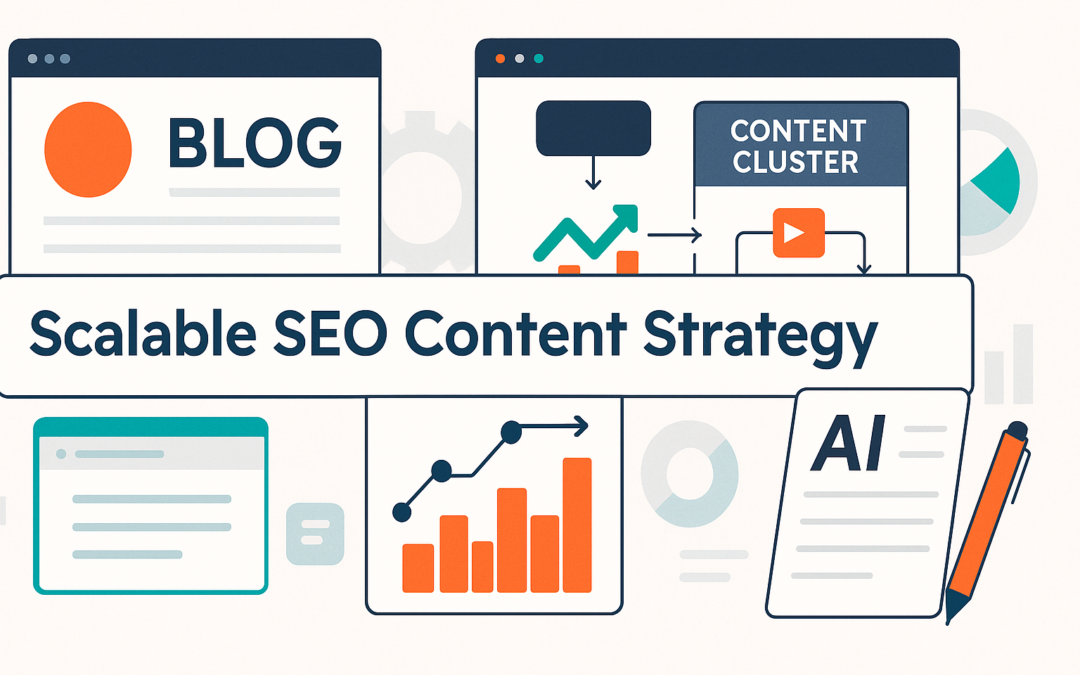Prefer Audio? Hear the Full Article Here
Introduction: Why Scalable Content Strategy Matters
In the age of information overload, creating content that not only ranks but also resonates with your audience is critical. Businesses are no longer just competing on product or price, they’re competing on content.
However, creating SEO-optimized content that aligns with business goals at scale is no easy task. It requires a strategic approach, intelligent tools, and automation capabilities.
That’s where HubSpot’s Content Strategy framework shines. As a HubSpot Solution Partner, we help businesses unlock the full potential of HubSpot’s tools to plan, create, optimize, and manage content that drives consistent, long-term traffic and leads.
Let’s explore how you can build and execute a scalable content strategy using HubSpot’s robust ecosystem.
Structuring Content with Topic Clusters and Pillar Pages
One of the biggest SEO challenges is content cannibalization, where multiple blog posts target the same keyword, confusing both Google and your readers. HubSpot solves this with its Topic Cluster model.
What are Topic Clusters?
A topic cluster is a group of related content pieces that link back to one central “pillar” page. This structure signals to search engines that your site has topical authority on that subject.
Why it works:
-
Improves internal linking
-
Enhances content organization
-
Boosts domain authority on specific topics
How to use it in HubSpot:
-
Use HubSpot’s SEO tool to create clusters around high-intent keywords
-
Build a pillar page (like “The Ultimate Guide to B2B Email Marketing”)
-
Link cluster blogs (like “5 Email A/B Tests for Better Open Rates”) back to the pillar
This strategy ensures your content scales logically and strategically, not randomly.
On-Page SEO Optimization with HubSpot’s SEO Recommendations
Even the best-written content can fall short if it’s not properly optimized. HubSpot’s SEO Recommendations tool scans your website and content for technical and on-page issues.
Before publishing any blog or page, HubSpot can check:
-
Missing or duplicate meta descriptions
-
Header structure issues (H1, H2 tags)
-
Broken links
-
Mobile optimization problems
-
Image alt-text and file naming issues
Why this matters:
Real-time feedback ensures that every piece of content is search-engine friendly from day one, saving time and improving ROI.
You can optimize blog posts during creation using inline suggestions, ensuring consistency across your entire team.
Scaling Content Creation with AI Assistance and Workflows
Creating high-quality content consistently is one of the biggest bottlenecks for marketers. HubSpot’s AI content assistant and workflow automation features help solve that.
How AI helps:
-
Generates content outlines and first drafts
-
Rewrites sections for clarity or tone
-
Suggests titles and meta descriptions
-
Translates content for multilingual strategies
Of course, human input is essential. But by using AI to handle the first 60% of the work, your team can focus on adding creativity, accuracy, and brand voice.
Combine this with automated workflows for:
-
Approvals and publishing
-
Lead nurturing after content interaction
-
Notifying sales when a high-value lead reads a strategic piece
This not only scales content production, but also the entire content lifecycle.
Creating Personalized Content Experiences with Smart Content
Generic content doesn’t convert. HubSpot allows you to dynamically personalize content based on visitor attributes using Smart Content.
You can personalize content by:
-
User’s lifecycle stage (lead vs. customer)
-
Device (desktop vs. mobile)
-
Geographic location
-
Contact list membership
Example:
A returning user from your email list can see a case study CTA, while a new visitor sees an ebook download offer all from the same page.
This improves engagement, conversion rates, and keeps your message relevant without doubling your content workload.
Measuring What Matters: HubSpot’s Content Analytics
You can’t scale what you don’t measure. HubSpot’s Content Analytics tools help track both macro and micro-level performance.
Key metrics include:
-
Page views and bounce rate
-
Time on page
-
Conversion rate by content type
-
Lead generation by content source
-
SEO keyword position tracking
These insights allow you to double down on high-performing content and optimize or retire underperforming pages.
HubSpot also integrates with Google Search Console and Google Analytics to provide a 360° view of your SEO performance.
Continuous Optimization and Growth
SEO isn’t a one-time task. It’s an evolving strategy. HubSpot makes it easier to revisit and refresh old content with tools that highlight:
-
Pages losing traffic
-
Outdated or thin content
-
Internal linking opportunities
-
New keywords to target
With this system in place, your content engine never sleeps… it improves with every piece of data.
Final Thoughts: Scale Smart, Not Just Fast
HubSpot isn’t just a content management system, it’s a content growth engine. With the right strategy and guidance, it can transform how you attract, convert, and retain customers through content.
As a certified HubSpot Solution Partner, we help companies like yours:
-
Design effective content structures
-
Set up topic clusters and SEO tools
-
Automate content delivery and lead workflows
-
Track content ROI across the funnel
Ready to Scale Your SEO Strategy with HubSpot?
Let our team of certified experts show you how HubSpot can drive organic growth for your business.

